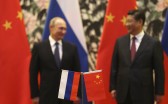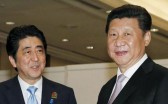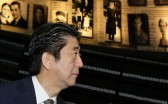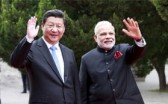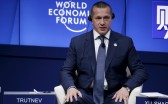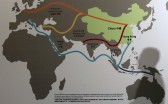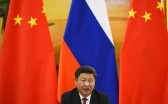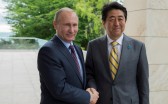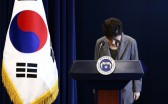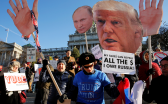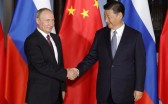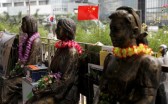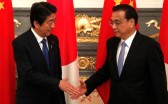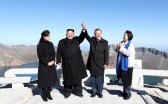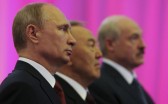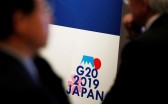“Pathways for Renewed Historical Tension between Japan and South Korea”
No issue so reliably sets Japan and South Korea against one another as “history”—a catch-all term for Japanese misbehavior in Korea during the colonial period. In 2018, the history issue could well re-emerge. The administration of President Moon Jae-in has, surprisingly, decided to not re-open the controversial 2015 South Korea-Japan deal on the comfort women. But he and his cabinet have rejected it as “insincere,” and Prime Minister Shinzo Abe threatened to avoid the Olympics in South Korea in retaliation. President Donald Trump’s threats of war in the region will likely submerge the issue for a time, but it will not disappear.
Western analysts have often noted the alignment of geopolitical interests between Japan and South Korea. They are in the same region, have the same ally, face the same opponents, and share the same political values. And now they both fear Trump’s unpredictability. Yet Moon has once again rejected “trilateralism.” South Korea continues to duck deep cooperation with Japan and insist on a siloed relationship with the United States. History is the roadblock. The ceiling for South Korea-Japan intergovernmental cooperation is quite low—but so is the floor. A nasty falling out is always just one crisis away. I see the following five possibilities for worsening impact of historical memory themes in 2018.
- Japanese Non-Governmental Rightist Outbursts
This is probably the most reliable predictor of a falling out. The Japanese government, contrary to the South Korean media’s portrayal, is actually rather responsible in its public statements on history. Rather, Japan-side flare-ups are often provoked by extra-governmental, bomb-throwing right-wing commentary about how colonialism was actually good for Korea and so on. The most provocative missives come from well-known figures, former public officials, retired military, and descendants of wartime officials. These purposeful provocations happen routinely enough, and often in the wake of sensitive moments, such as wartime apologies or negotiations over the comfort women, that South Koreans tend to take them as semi-public pronouncements. Similarly unhelpful are Japanese officials visiting the Yasukuni Shrine in their “private capacity,” a transparently bogus distinction.
The Japanese government should more clearly speak against these sorts of op-eds and speeches. But it would also help if the South Korean side could accept the reality of both pluralism and press freedom in modern Japan. There is simply no way the Japanese government can, or should, stop these statements. There will inevitably be outbursts South Koreans dislike from any open society, and it would demonstrate South Korean maturity if the Seoul media would ignore them more often.
- Fire-Breathing South Korean Media Irresponsibility
The South Korean media have a disappointing propensity to publish anti-Japanese agit-prop. The most notorious recent case is the JoongAng Daily’s 2013 publication of an op-ed calling the atom bomb drop “God’s vengeance” on Japan. Another highlight beloved by Western analysts of this debate is a 2012 Korea Times’ ‘story’ about a looming samurai invasion of Dokdo. The prosecution and media character assassination of South Korean scholar Park Yu-Ha for a book disputing the “correct” history of the “comfort women” similarly reflects this problem.
In my experience, serious South Koreans realize this sets back rapprochement but are uncomfortable calling it out publicly. Usually op-eds in South Korean media calling for greater South Korea-Japan cooperation are by Western analysts, or at best, Korean-Americans like Victor Cha. There is a local code of silence on history, as Park learned, because it is politically risky to push against the anti-Japanism deeply woven into modern South Korean nationalism.
South Koreans also miss that Japanese media pick up these stories and re-broadcast them. In the many years I have written for Japanese media, I have been asked about them again and again. Greater professionalism from the South Korean media would help.
- Annual Provocation Opportunities: Takeshima Day, Yasukuni Visits, South Korean Films…
Japanese and South Korean recriminations crop up around fairly predictable moments each year. Japan’s Takeshima Day, February 22, is an obvious candidate for nationalists on all sides to vent incendiary commentary. Annual Yasukuni visits by Japanese officials— accompanied by endless prevarication over who from the government should go and if going in a “private capacity” somehow alleviates the visit’s impact—provide yet another regular opportunity for history to capture the headlines on both sides. And recently, the South Korean film industry has waded into this tangle with regular nationalist blockbusters with Japanese villains, such as My Way (2011), The Admiral: Roaring Currents (2014), Assassination (2015), and Battleship Island (2017).
All these moments provide almost ritualized occasions for non-governmental and nationalist civic groups to fill the papers and airwaves with explosive accusations. These in turn ensure the constant possibility of a slide into spirals of tit-for-tat recrimination. The sheer volume of opportunities for nationalists to make trouble on either side ensures that history is never far from the headlines.
- The Death of a “Comfort Woman” and Statue Erection
The slow passing of the remaining “comfort women” in South Korea is yet another lightning rod which regularly threatens to re-ignite the history debate. The “comfort women” have achieved a “secular saint” status in South Korea. The wrongs they suffered have come to embody South Korean anxieties and resentments over the colonial period as a whole. With only thirty-one still alive, the passing of each is a major event in the South Korean media, and the Japanese government’s unhelpful refusal to say anything at these moments only deepens South Korean suspicions about Japanese contrition.
Worse, as the surviving victims’ numbers dwindle, the possibility increases that they may all die before Japan apologizes in a manner South Koreans find sincere. Should this happen, the “comfort women” problem may “lock-in” as a permanent feature of Korean-Japanese relations. This will not happen in 2018, but given the women’s advanced age, this will likely occur in less than a decade. This sets something of a timer on the South Korean side for a Japanese apology, while Tokyo seems to be simply waiting on their final passing to naturally eliminate the issue. This is unlikely. Far more probable is that the “comfort women’s” final passing without contrition acceptable to them, their families, and the South Korean public more generally, will freeze the conflict indefinitely.
The accelerating erection of comfort women statues in South Korea and around the world compounds the above problem and may lead to a serious breach if overseas Korean associations push for a statue in a very high-profile location, particularly in the United States. The Japanese government hotly opposes these, which Korean civic groups seem to relish. Their installation is now increasingly politicized and a part of South Korea’s general competition with Japan. That this is accelerating rather than slowing, suggests how little the 2015 “comfort women” deal resonates in South Korea, as well as a new Korean strategy for global attention to this issue. Global blowback is to cross-pressure Japan into greater contrition.
But the statues are risky. Their installation in front of the Japanese embassy in Seoul and consulate in Busan arguably violates the Vienna Diplomacy Convention’s prohibition against undue harassment of diplomats. And the internationalization strategy raises a fetishization critique: so unwilling are South Koreans to let this go, that they will export their conflict to other locales with little role in the Asian history debate.
- Japanese Administrative Shifts: Textbooks, Claims to Dokdo/Takeshima, Historical Interpretations/Statements
The final issue that might revive the history debates this year is any formal Japanese government statements or descriptions of relevant events. These are closely watched by the South Korean government. Formal claims to Takeshima activate a regular South Korean response. President Lee Myung-bak even went to Dokdo to capitalize on the issue. Textbook changes are not lost in the bureaucratic shuffle; the South Korean media quickly picks up on every convoluted, politicized Japanese compromise over how to describe the events of the first half of the twentieth century to the next generation. And formal government statements on historical events are routinely found insufficient by South Korean elites—on the fiftieth and seventieth anniversaries of the end of the Pacific War, for example. Thankfully no major anniversaries are on the horizon, nor does Tokyo seem to be formally addressing these issues in a major way this coming year.
These five possibilities might be best understood as mobilization points or, to stretch a political science concept, the “political opportunity structure” of the South Korean-Japanese contention over history. Any one of these provides an opportunity around which vested political actors—not just governments, but non-governmental and civic groups as well—can mobilize. Year-in and year-out, these mobilization points provide a regular series of opportunities for the issues to re-surface and possibly spin out of control. This in turn routinely sets back progress—such as the GSOMIA intelligence sharing deal—and forces reconciliation to start all over again.
Hence, it is overly optimistic to read the recent lack of outbursts around these mobilization points as progress in bilateral relations itself. As long as they remain unresolved, and the political beliefs of actors in both camps are intact, the lack of recriminations is just stop-gap muddling through. To be sure, this is better than nothing. South Korean-Japanese tension was so bad a few years ago, that books were written on the subject and no less than the US president had to step in to smooth over the fracas. So stumbling from one potential controversy to another without a blow-up is progress of a sort. But real improvement will only come when these issues no longer act as mobilizing potentials sending the nationalist NGOs into the streets or filling the op-ed pages with hyperbolic antipathy.
Here there is good news. Polls repeatedly find majorities in both countries want better relations. And South Korean and Japanese elites both clearly know that this relationship is dysfunctional and needs to change. In ten years living in South Korea, I have never met an official or academic from either side who approves of the status quo. Instead, almost all have suggested that North Korea and China are more important issues than history with Japan, and that history needs to be wrapped up so that South Korea and Japan can move onto these bigger issues. The problem is the code of silence, especially powerful on the South Korean side. It is politically risky to come out in favor of improved relations and criticize the maximalists in one’s own camp. It is always easier to play the “history card” for quick point-scoring, such as Lee’s trip to Dokdo, or Abe’s relentless dancing around the reality of the “comfort women.”
The way forward then is, ultimately, facing down the ultra-nationalists at home. This requires intra-Korean and intra-Japanese debates, in which moderates show political courage and call out the nationalist right for unnecessarily firing up history issues and making compromise impossible. The 2015 Park Geun-hye approach—in which the nationalists and civic groups are simply ignored in the deal-making—is unsustainable. In a democracy, resonant, deeply committed interest groups—as the nationalists are on history—must have voice opportunities. They must be brought into the process or co-opted in some way. It is not surprising that the South Korean public dislikes the supposedly (but not really) “final” “comfort women” deal.
This year’s geopolitical tensions—North Korean nuclear weapons, Trump, the possibility of war—will likely drown out the history problem. But that is a stay, more muddling through, not a resolution. The mobilization points I list still resound with the publics of both countries. They still provide a political opportunity structure for free-lancing nationalists to re-surface these issues and upend relations. I see little movement on the underlying tensions, even if this year is quiet.
The political movement necessary to defuse these issues will be toughest on the South Korean side. Where this is one issue among many in Japan, South Korean nationalism is overwhelmingly focused on Japan and the colonial period. The “comfort women” and Dokdo particularly have near sacral status, as one can see in Independence Day events, films, scholarship, or public imagery, such as the proliferating statues (now on buses), Dokdo paintings on public transportation, or Dokdo live-feed cameras in South Korean government buildings. South Korean media and public personalities routinely claim that Japan’s apologies are not “sincere.” This may be so, but the South Korean insistence, for example, on a Willy Brandt-style apology will never come to fruition. Japan will never accept that its behavior in Korea was akin to the Holocaust. Whether South Koreans can accept something less dramatic is the most important decision point now in how the history issue evolves. The Japanese right could make this much easier if it would stop preposterously disputing otherwise established imperial history, but ultimately it is South Koreans who must make a moral decision at some point (or not) to move on.
Robert E. Kelly (@Robert_E_Kelly) is a professor of international relations in the Department of Political Science and Diplomacy at Pusan National University. More of his work may be found at his website, AsianSecurityBlog.wordpress.com.

